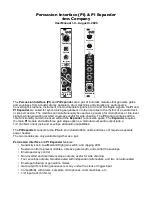
Envelopes in Gen Mode
When the
PI
is in
Gen.
mode, it will generate a consistent envelope shape each time it’s triggered. In
this mode, the
Gate
will always fire at the same time as the envelope. When triggered, the envelope will
rise quickly with a very fast attack, and then sustain for a period of time set by the
Sustain
knob. The
sustain period is the same amount of time as the gate pulse width. After sustaining, the envelope will
decay back to 0V at a rate set by the
Decay
knob.
Figures 1
and
2
illustrate this process. The input signal is
shown in red, the gate output in orange, and the envelope
output in blue.
In
Figure 1
, the
Sustain
pot is set to about 50% and the
envelope sustains as long as the gate is also high. In
Figure 2
, the
Sustain
pot is turned fully counter-clockwise
and both the pulse width of the gate output and the sustain
period of the envelope become very short.
Gen.
mode is useful for isolating a sound source. For
example, when using a microphone to sense the sound of
a snare drum, other parts of the drum set could be loud
enough to trigger the
PI
. In
Gen.
mode, it’s easy to adjust
Sensitivity
until unwanted
envelopes and gates are no longer generated.
Another use case for
Gen.
mode is to trigger a
PI
with one
part of a drum (say, the snare head), but not with another
part of the drum (say, the rim). By setting the
L|M|H
switch
and
Sensitivity
knob appropriately, and placing the
microphone in a location where it picks up the head louder
than the rim, you can isolate the two regions. This
technique can be extended to use two
PI
modules on a
single drum: the rim triggers one
PI
, and the head triggers
another
PI
.
If you don’t want the
PI
to trigger every time a drum is
struck, but only want it fire when the drum is hit with high
velocity, the
Sensitivity
knob can be set very low. Gates and envelopes will be generated
from loud signals while quiet signals will have no effect on the
PI
. This technique of setting
a high threshold is useful if you want to trigger events such as advancing a sequencer, or play periodic
sounds (such as a long sample) instead of tracking every drum hit. This technique can also be
extended when using multiple
PI
modules: each unit can be set to fire at a different velocity, thus
allowing control of complex sounds and events from a single drum.
Page of
8
16
Figure 2
Figure 1


































